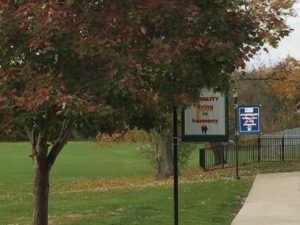Why Do Leaves Change Color?
 The Outdoor Learning classes have been exploring the mystery on why trees change into so many different colors this time of year. Is it really a mystery? The color of leaves throughout the year is created by chemical pigments found in the leaf. During the growing season, the leaves are healthy and green due to the predominance of a green pigment called chlorophyll. Chlorophyll is an important chemical in the process of photosynthesis, the process by which plants manufacture their own food. As fall approaches, deciduous trees (trees with leaves and not needles) slow down their food production. The green pigment breaks down and other pigments in the leaves are exposed, revealing a variety of possible colors. Different trees contain different masked color pigments, causing a spectrum of colors each fall (just look outside!). Thus, the type of leaf pigment contained within leaves will determine their autumn color. Carotene produces yellow and orange leaves (just like carrots). Tannins in oak and beech trees produce a brown leaf hue. However, it is the red pigment and the increased accumulation of sugar in the leaf that creates all those magical fall colors. Warm sunny days and cool nights are the perfect recipe for the magnificent sugar maples and the sassafras trees to shine brightly with all their yellow, red, and orange leaves. So as the students have learned, the mystery of autumn leaf color isn’t a mystery at all; it’s simply an effective mechanism for winter survival.
The Outdoor Learning classes have been exploring the mystery on why trees change into so many different colors this time of year. Is it really a mystery? The color of leaves throughout the year is created by chemical pigments found in the leaf. During the growing season, the leaves are healthy and green due to the predominance of a green pigment called chlorophyll. Chlorophyll is an important chemical in the process of photosynthesis, the process by which plants manufacture their own food. As fall approaches, deciduous trees (trees with leaves and not needles) slow down their food production. The green pigment breaks down and other pigments in the leaves are exposed, revealing a variety of possible colors. Different trees contain different masked color pigments, causing a spectrum of colors each fall (just look outside!). Thus, the type of leaf pigment contained within leaves will determine their autumn color. Carotene produces yellow and orange leaves (just like carrots). Tannins in oak and beech trees produce a brown leaf hue. However, it is the red pigment and the increased accumulation of sugar in the leaf that creates all those magical fall colors. Warm sunny days and cool nights are the perfect recipe for the magnificent sugar maples and the sassafras trees to shine brightly with all their yellow, red, and orange leaves. So as the students have learned, the mystery of autumn leaf color isn’t a mystery at all; it’s simply an effective mechanism for winter survival.



Follow and Contact Us